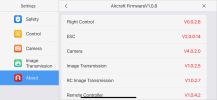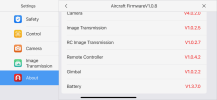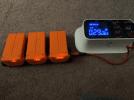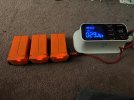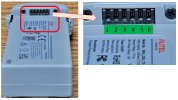Does the Autel Nano+ charger use PD (Power Delivery) or QuickCharge protocol?
It looks like the wall adapter is supporting USB PD2.0 1.0.
The small print (through magnifying glass) says:
Output USB-C 5.0v=3.0A, 9.0v=3.0A, 12.0v=2.5A 30.0W
USB-A 5.0v=3.0A, 9.0V=2.0A, 12.0v=1.5A 18.0W
I've been using the big USB-A port. Is charging faster with the small USB-C @30W max??
USB PD 2.0 supports 5V-3A, 9V-3A, 12V-3A (36W), 15V-3A (45W), 20V-5A (100W)
The Autel product page says battery supports charging up to 30W, and it'd be unusual for such a small pack to support a 45W or 100W charging rate.
The battery has a capacity of 2250mAh @ 7.7V = 17.325 Wh. LiFePO4 doesn't charge at constant current but with a CC/CV two-stage process, so we can't estimate charging time based on max wattage the adapter can supply.
Autel says battery takes 90 min to charge, which means average charing power is only 17.3/1.5 = 11.55 Watts. That's well below the 30W spec, even accounting for the second stage, slower CV charge phase.
In the field one could run PD USB chargers off a 24 v battery feeding several EVO Nano chargers.,
To keep up with continous flying one would need to charge about 3 batteries per hour, which would require 5 chargers and a total of 6 batteries, one in the flying Nano+.
It would be nice if we could get a charge time per battery down to under 80 minutes, so only four chargers would be needed for continous flying.
This might be possible if the CC charge mode would take PD 2.0 12V @ 3.0A (36W) instead of just 30W.
I'll try other PD USB power supplies and report back if I can get under 80 minutes full charge time.
Please chime-in if you have done any measurements yourself.
Please let me know if you find anything incorrect in what i've written, thank you.
It looks like the wall adapter is supporting USB PD
The small print (through magnifying glass) says:
Output USB-C 5.0v=3.0A, 9.0v=3.0A, 12.0v=2.5A 30.0W
USB-A 5.0v=3.0A, 9.0V=2.0A, 12.0v=1.5A 18.0W
I've been using the big USB-A port. Is charging faster with the small USB-C @30W max??
USB PD 2.0 supports 5V-3A, 9V-3A, 12V-3A (36W), 15V-3A (45W), 20V-5A (100W)
The Autel product page says battery supports charging up to 30W, and it'd be unusual for such a small pack to support a 45W or 100W charging rate.
The battery has a capacity of 2250mAh @ 7.7V = 17.325 Wh. LiFePO4 doesn't charge at constant current but with a CC/CV two-stage process, so we can't estimate charging time based on max wattage the adapter can supply.
Autel says battery takes 90 min to charge, which means average charing power is only 17.3/1.5 = 11.55 Watts. That's well below the 30W spec, even accounting for the second stage, slower CV charge phase.
In the field one could run PD USB chargers off a 24 v battery feeding several EVO Nano chargers.,
To keep up with continous flying one would need to charge about 3 batteries per hour, which would require 5 chargers and a total of 6 batteries, one in the flying Nano+.
It would be nice if we could get a charge time per battery down to under 80 minutes, so only four chargers would be needed for continous flying.
This might be possible if the CC charge mode would take PD 2.0 12V @ 3.0A (36W) instead of just 30W.
I'll try other PD USB power supplies and report back if I can get under 80 minutes full charge time.
Please chime-in if you have done any measurements yourself.
Please let me know if you find anything incorrect in what i've written, thank you.
Last edited:



